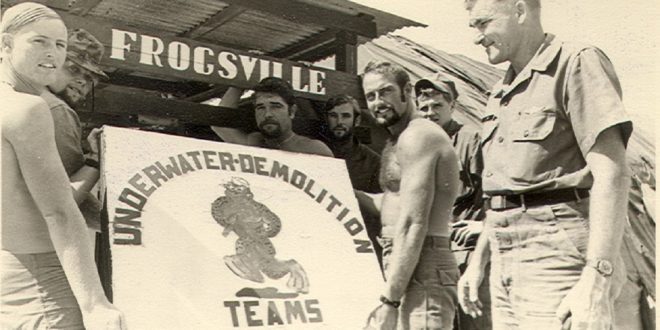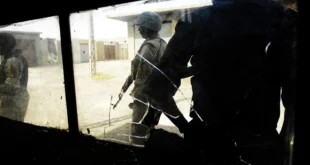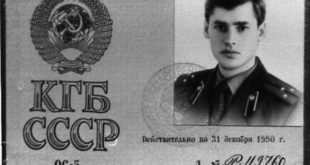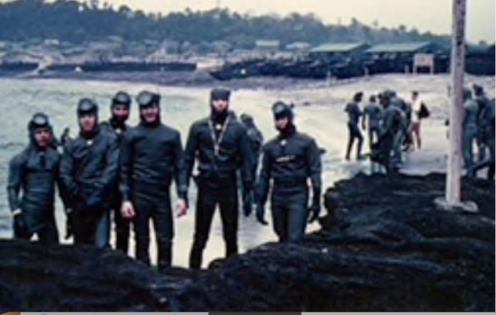
Although not formally founded until 1962, the beginnings of SEALs trace back to when the U.S. military saw a need for a beach reconnaissance force. A coalition of “Scouts and Raiders” were formed in 1942.
Today’s Naval Special Warfare operators can trace their origins to the Scouts and Raiders, Naval Combat Demolition Units, Office of Strategic Services Operational Swimmers, Underwater Demolition Teams, and Motor Torpedo Boat Squadrons of World War II.
While none of those early organizations have survived to present, their pioneering efforts in unconventional warfare are mirrored in the missions and professionalism of the present Naval Special Warfare warriors.
To meet the need for a beach reconnaissance force, selected Army and Navy personnel assembled at Amphibious Training Base, Little Creek, on 15 August 1942 to begin Amphibious Scouts and Raiders (Joint) training. The Scouts and Raiders mission was to identify and reconnoiter the objective beach, maintain a position on the designated beach prior to a landing and guide the assault waves to the landing beach.
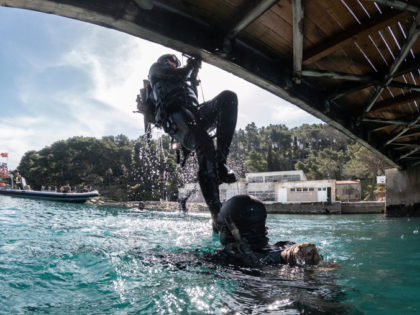
The first group included Phil H. Bucklew, the “Father of Naval Special Warfare,” after whom the Naval Special Warfare Center building is named. Commissioned in October 1942, this group saw combat in November 1942 during OPERATION TORCH, the first allied landings in Europe, on the North African coast. Scouts and Raiders also supported landings in Sicily, Salerno, Anzio, Normandy, and southern France.
A second group of Scouts and Raiders, code-named Special Service Unit #1, was established on July 7, 1943, as a joint and combined operations force. The first mission, in September 1943, was at Finschafen on New Guinea. Later ops were at Gasmata, Arawe, Cape Gloucester, and the East and South coast of New Britain, all without any loss of personnel. Conflicts arose over operational matters, and all non-Navy personnel were reassigned. The unit, renamed 7th Amphibious Scouts, received a new mission, to go ashore with the assault boats, buoy channels, erect markers for the incoming craft, handle casualties, take offshore soundings, blow up beach obstacles and maintain voice communications linking the troops ashore, incoming boats and nearby ships. The 7th Amphibious Scouts conducted operations in the Pacific for the duration of the conflict, participating in more than 40 landings.
The third Scout and Raiders organization operated in China. Scouts and Raiders were deployed to fight with the Sino-American Cooperation Organization, or SACO. To help bolster the work of SACO, Admiral Ernest J. King ordered that 120 officers and 900 men be trained for “Amphibious Roger” at the Scout and Ranger school at Ft. Pierce, FL. They formed the core of what was envisioned as a “guerrilla amphibious organization of Americans and Chinese operating from coastal waters, lakes and rivers employing small steamers and sampans.” While most Amphibious Roger forces remained at Camp Knox in Calcutta, three of the groups saw active service. They conducted a survey of the Upper Yangtze River in the spring of 1945 and, disguised as coolies, conducted a detailed three-month survey of the Chinese coast from Shanghai to Kitchioh Wan, near Hong Kong.
In September of 1942, 17 Navy salvage personnel arrived at ATB Little Creek, VA for a one-week concentrated course on demolitions, explosive cable cutting and commando raiding techniques. On 10 November 1942, this first combat demolition unit succeeded in cutting a cable and net barrier across the Wadi Sebou River during Operation TORCH in North Africa. Their actions enabled the USS DALLAS (DD 199) to traverse the river and insert U.S. Rangers who captured the Port Lyautey airdrome.
Plans for a massive cross-channel invasion of Europe had begun and intelligence indicated that the Germans were placing extensive underwater obstacles on the beaches at Normandy. On 7 May 1943, LCDR Draper L. Kauffman, “The Father of Naval Combat Demolition,” was directed to set up a school and train people to eliminate obstacles on an enemy-held beach prior to an invasion.
On 6 June 1943, LCDR Kaufmann established Naval Combat Demolition Unit training at Ft. Pierce. By April 1944, a total of 34 NCDUs were deployed to England in preparation for Operation OVERLORD, the amphibious landing at Normandy.
On 6 June 1944, in the face of great adversity, the NCDUs at Omaha Beach managed to blow eight complete gaps and two partial gaps in the German defenses. The NCDUs suffered 31 killed and 60 wounded, a casualty rate of 52%. Meanwhile, the NCDUs at Utah Beach met less intense enemy fire. They cleared 700 yards of beach in two hours, another 900 yards by the afternoon. Casualties at Utah Beach were significantly lighter with 6 killed and 11 wounded. During Operation OVERLORD, not a single demolitioneer was lost to improper handling of explosives.
In August 1944, NCDUs from Utah Beach participated in the landings in southern France, the last amphibious operation in the European Theater of Operations.
NCDUs also operated in the Pacific theater. NCDU 2, under LTjg Frank Kaine, after whom the Naval Special Warfare Command building is named, and NCDU 3 under LTjg Lloyd Anderson, formed the nucleus of six NCDUs that served with the Seventh Amphibious Force tasked with clearing boat channels after the landings from Biak to Borneo.
Some of the earliest World War II predecessors of the SEALs were the Operational Swimmers of the Office of Strategic Services, or OSS. Many current SEAL missions were first assigned to them.
British Combined Operations veteran LCDR Wooley, of the Royal Navy, was placed in charge of the OSS Maritime Unit in June 1943.
Their training started in November 1943 at Camp Pendleton, moved to Catalina Island in January 1944, and finally moved to the warmer waters in the Bahamas in March 1944. Within the U.S. military, they pioneered flexible swim fins and facemasks, closed-circuit diving equipment, the use of swimmer submersibles, and combat swimming and limpet mine attacks.
In May 1944, GEN Donovan, the head of the OSS, divided the unit into groups. He loaned Group 1, under LT Choate, to ADM Nimitz, as a way to introduce the OSS into the Pacific Theater. They became part of UDT-10 in July 1944. Five OSS men participated in the very first UDT submarine operation with the USS BURRFISH in the Caroline Islands in August 1944.
Admiral Chester Nimitz’s “Granite Plan” for central Pacific operations required an efficient amphibious force. Many of the targeted islands were coral atolls with reefs that acted as natural obstacles to landings. During early November 1943, SeaBees engaged in experimental underwater blasting work were assembled at Waipio Amphibious Operating Base on Oahu to begin training in underwater demolition.
On 23 November 1943, the U. S. Marine landing on Tarawa Atoll emphasized the need for hydrographic reconnaissance and underwater demolition of obstacles prior to any amphibious landing.
After Tarawa, 30 officers and 150 enlisted men were moved to Waimanalo Amphibious Training Base to form the nucleus of a demolition training program. This group became Underwater Demolition Teams (UDT) ONE and TWO.
The UDTs saw their first combat on 31 January 1944, during Operation FLINTLOCK in the Marshall Islands. FLINTLOCK became the real catalyst for the UDT training program in the Pacific Theater. In February 1944, the Naval Combat Demolition Training and Experimental Base was established at Kihei, Maui, next to the Amphibious Base at Kamaole.
Eventually, 34 UDT teams were established. Wearing swim suits, fins, and facemasks on combat operations, these “Naked Warriors” saw action across the Pacific in every major amphibious landing including: Eniwetok, Saipan, Guam, Tinian, Angaur, Ulithi, Pelilui, Leyte, Lingayen Gulf, Zambales, Iwo Jima, Okinawa, Labuan, Brunei Bay, and on 4 July 1945 at Balikpapan on Borneo which was the last UDT demolition operation of the war.
The rapid demobilization at the conclusion of the war reduced the number of active duty UDTs to two on each coast with a complement of 7 officers and 45 enlisted men each.
The Korean War began on 25 June 1950, when the North Korean army invaded South Korea. Beginning with a detachment of 11 personnel from UDT 3, UDT participation expanded to three teams with a combined strength of 300 men.
As part of the Special Operations Group, or SOG, UDTs successfully conducted demolition raids on railroad tunnels and bridges along the Korean coast.
On 15 September 1950, UDTs supported Operation CHROMITE, the amphibious landing at Inchon. UDT 1 and 3 provided personnel who went in ahead of the landing craft, scouting mud flats, marking low points in the channel, clearing fouled propellers, and searching for mines. Four UDT personnel acted as wave-guides for the Marine landing.
In October 1950, UDTs supported mine-clearing operations in Wonsan Harbor where frogmen would locate and mark mines for minesweepers. On 12 October 1950, two U.S. minesweepers hit mines and sank. UDTs rescued 25 sailors. The next day, William Giannotti conducted the first U.S. combat operation using an “aqualung” when he dove on the USS PLEDGE.
For the remainder of the war, UDTs conducted beach and river reconnaissance, infiltrated guerrillas behind the lines from sea, continued mine sweeping operations, and participated in Operation FISHNET, which severely damaged the North Korean’s fishing capability.
Responding to President Kennedy’s desire for the Services to develop an Unconventional Warfare (UW) capability, the U.S. Navy established SEAL Teams ONE and TWO in January of 1962. Formed entirely with personnel from Underwater Demolition Teams, the SEALs mission was to conduct counter guerilla warfare and clandestine operations in maritime and riverine environments.
SEAL involvement in Vietnam began immediately and was advisory in nature. SEAL advisors instructed the Vietnamese in clandestine maritime operations. SEALs also began a UDT style training course for the Biet Hai Commandos, the Junk Force Commando platoons, in Danang.
In February 1966, a small SEAL Team ONE detachment arrived in Vietnam to conduct direct-action missions. Operating out of Nha Be, in the Rung Sat Special Zone, this detachment signaled the beginning of a SEAL presence that would eventually include 8 SEAL platoons in country on a continuing basis. Additionally, SEALs served as advisors for Provincial Reconnaissance Units and the Lien Doc Nguoi Nhia, or LDNN, the Vietnamese SEALs. The last SEAL platoon departed Vietnam on 7 December 1971. The last SEAL advisor left Vietnam in March 1973.
The UDTs again saw combat in Vietnam while supporting the Amphibious Ready Groups. When attached to the riverine groups the UDTs conducted operations with river patrol boats and, in many cases, patrolled into the hinterland as well as along the riverbanks and beaches in order to destroy obstacles and bunkers. Additionally, UDT personnel acted as advisors.
On May 1, 1983, all UDTs were redesignated as SEAL Teams or Swimmer Delivery Vehicle Teams (SDVT). SDVTs have since been redesignated SEAL Delivery Vehicle Teams.
Special Boat Units can also trace their history back to WWII. The Patrol Coastal and Patrol Boat Torpedo are the ancestors of today’s PC and MKV. Motor Torpedo Boat Squadron THREE rescued General MacArthur (and later the Filipino President) from the Philippines after the Japanese invasion and then participated in guerrilla actions until American resistance ended with the fall of Corregidor. PT Boats subsequently participated in most of the campaigns in the Southwest Pacific by conducting and supporting joint/combined reconnaissance, blockade, sabotage, and raiding missions as well as attacking Japanese shore facilities, shipping, and combatants. PT Boats were used in the European Theater beginning in April 1944 to support the OSS in the insertions of espionage and French Resistance personnel and for amphibious landing deception. While there is no direct line between organizations, NSW embracement is predicated on the similarity in craft and mission.
The development of a robust riverine warfare capability during the Vietnam War produced the forerunner of the modern Special Warfare Combatant-craft Crewman. Mobile Support Teams provided combat craft support for SEAL operations, as did Patrol Boat, Riverine (PBR) and Swift Boat sailors. In February 1964, Boat Support Unit ONE was established under Naval Operations Support Group, Pacific to operate the newly reinstated Patrol Torpedo Fast (PTF) program and to operate high-speed craft in support of NSW forces. In late 1964 the first PTFs arrived in Danang, Vietnam. In 1965, Boat Support Squadron ONE began training Patrol Craft Fast crews for Vietnamese coastal patrol and interdiction operations. As the Vietnam mission expanded into the riverine environment, additional craft, tactics, and training evolved for riverine patrol and SEAL support.
SEAL Delivery Vehicle Teams historical roots began during WWII, however with Italian and British combat swimmers and wet submersibles. Naval Special Warfare entered the submersible field in the 1960’s when the Coastal Systems Center developed the Mark 7, a free-flooding SDV of the type used today, and the first SDV to be used in the fleet. The Mark 8 and 9 followed in the late 1970’s. Today’s Mark 8 Mod 1 and the soon to be accepted for fleet use Advanced SEAL Delivery System (ASDS), a dry submersible, provide NSW with an unprecedented capability that combines the attributes of clandestine underwater mobility and the combat swimmer.
Post-Vietnam War operations that NSW forces have participated in include URGENT FURY (Grenada 1983); EARNEST WILL (Persian Gulf 1987-1990); JUST CAUSE (Panama 1989-1990) and DESERT SHIELD/DESERT STORM (Middle East/Persian Gulf 1990-1991). Additionally, NSW conducted missions in Somalia, Bosnia, Haiti, Liberia.
In response to the attacks on America Sept. 11, 2001, Naval Special Warfare forces put operators on the ground in Afghanistan in October. The first military flag officer to set foot in Afghanistan was a Navy SEAL in charge of all special operations for Central Command. Additionally, a Navy SEAL captain commanded Combined Joint Special Operations Task Force (CJSOTF) South. Commonly referred to as Task Force K-BAR, the task force included U.S. Navy, Army, Air Force and Coalition SOF forces. During Operation Enduring Freedom, NSW forces carried out more than 75 special reconnaissance and direct action missions, destroying more than 500,000 pounds of explosives and weapons; positively identifying enemy personnel and conducting Leadership Interdiction Operations in the search for terrorists trying to escape by sea-going vessels.
Naval Special Warfare has played a significant role in Operation Iraqi Freedom, employing the largest number of SEALs and SWCC in its history. NSW forces were instrumental in numerous special reconnaissance and direct action missions including the securing of the southern oil infrastructures of the Al Faw peninsula and the off-shore gas and oil terminals; the clearing of the Khawr Abd Allah and Khawr Az Zubayr waterways that enabled humanitarian aid to be delivered to the vital port city of Umm Qasr; reconnaissance of the Shat Al Arab waterway; capture of high value targets, raids on suspected chemical, biological and radiological sites; and the first POW rescue since WWII. Additionally, NSW is also fighting the war on terrorism in other global hot spots including the Philippines and the Horn of Africa.
NSW is committed to its Sailors and the deliberate assessment and development of their tactical excellence, ethics, and leadership as the nation’s premiere maritime special operations force supporting the National Defense Strategy. It is the maritime component of USSOCOM, and its mission is to provide maritime special operations forces to conduct full-spectrum operations, unilaterally or with partners, to support national objectives.
 Soldier of Fortune Magazine The Journal of Professional Adventurers
Soldier of Fortune Magazine The Journal of Professional Adventurers


